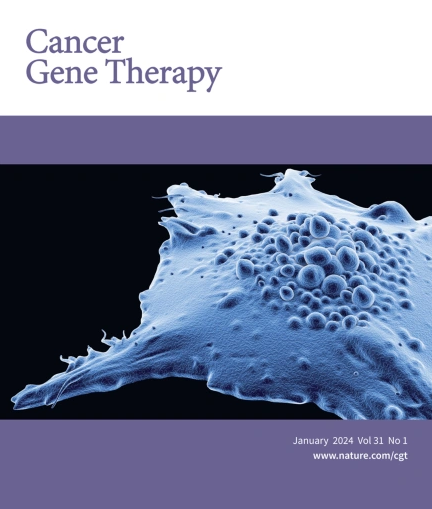The Exon Junction Complex component EIF4A3 plays a splicing-linked oncogenic role in pancreatic ductal adenocarcinoma
IF 4.8
3区 医学
Q1 BIOTECHNOLOGY & APPLIED MICROBIOLOGY
引用次数: 0
Abstract
Pancreatic ductal adenocarcinoma (PDAC) is one of the most lethal cancers, underscoring the urgent need for in-depth biological research. The phenomenon of alternative RNA splicing dysregulation is a common hallmark in cancer, including PDAC, presenting new avenues for understanding and developing diagnostic and therapeutic tools. Our research focuses on EIF4A3, a core component of the Exon Junction Complex intimately linked to RNA splicing, and its role in PDAC. EIF4A3 is overexpressed in PDAC tissue and associated to clinical parameters of malignancy and poorer patient survival. Mechanistically, exploration of PDAC RNA-seq data unveiled the link of EIF4A3 to diverse malignancy processes, consistent with its association to key molecular pathways. EIF4A3 targeting in vitro decreased essential functional tumor features such as proliferation, migration, colony formation and sphere formation, while its in vivo targeting reduced tumor growth. EIF4A3 silencing in PDAC cell lines severely altered its transcriptional and spliceosomic landscapes, as shown by RNA-seq analyses, suggesting a role for EIF4A3 in maintaining RNA homeostasis. Our results indicate that EIF4A3 dysregulation in PDAC has a pleiotropic regulatory role on RNA biology, influencing key cellular functions. This paves the way to explore its potential as novel biomarker and actionable target candidate for this lethal cancer.


外显子连接复合体成分 EIF4A3 在胰腺导管腺癌中发挥着与剪接相关的致癌作用。
胰腺导管腺癌(PDAC)是致死率最高的癌症之一,因此迫切需要进行深入的生物学研究。替代 RNA 剪接失调现象是包括 PDAC 在内的癌症的常见特征,为了解和开发诊断与治疗工具提供了新途径。我们的研究重点是与 RNA 剪接密切相关的外显子连接复合体的核心成分 EIF4A3 及其在 PDAC 中的作用。EIF4A3 在 PDAC 组织中过表达,并与恶性肿瘤的临床参数和较差的患者生存率相关。从机理上讲,对 PDAC RNA-seq 数据的探索揭示了 EIF4A3 与多种恶性肿瘤过程的联系,这与其与关键分子通路的关联是一致的。体外靶向 EIF4A3 可减少肿瘤的基本功能特征,如增殖、迁移、集落形成和球体形成,而体内靶向 EIF4A3 可减少肿瘤生长。RNA-seq分析表明,在PDAC细胞系中沉默EIF4A3会严重改变其转录和剪接体结构,这表明EIF4A3在维持RNA稳态方面发挥作用。我们的研究结果表明,PDAC 中的 EIF4A3 失调对 RNA 生物学具有多向调控作用,影响着细胞的关键功能。这为探索其作为新型生物标记物和治疗这种致命癌症的候选靶点的潜力铺平了道路。
本文章由计算机程序翻译,如有差异,请以英文原文为准。
求助全文
约1分钟内获得全文
求助全文
来源期刊

Cancer gene therapy
医学-生物工程与应用微生物
CiteScore
10.20
自引率
0.00%
发文量
150
审稿时长
4-8 weeks
期刊介绍:
Cancer Gene Therapy is the essential gene and cellular therapy resource for cancer researchers and clinicians, keeping readers up to date with the latest developments in gene and cellular therapies for cancer. The journal publishes original laboratory and clinical research papers, case reports and review articles. Publication topics include RNAi approaches, drug resistance, hematopoietic progenitor cell gene transfer, cancer stem cells, cellular therapies, homologous recombination, ribozyme technology, antisense technology, tumor immunotherapy and tumor suppressors, translational research, cancer therapy, gene delivery systems (viral and non-viral), anti-gene therapy (antisense, siRNA & ribozymes), apoptosis; mechanisms and therapies, vaccine development, immunology and immunotherapy, DNA synthesis and repair.
Cancer Gene Therapy publishes the results of laboratory investigations, preclinical studies, and clinical trials in the field of gene transfer/gene therapy and cellular therapies as applied to cancer research. Types of articles published include original research articles; case reports; brief communications; review articles in the main fields of drug resistance/sensitivity, gene therapy, cellular therapy, tumor suppressor and anti-oncogene therapy, cytokine/tumor immunotherapy, etc.; industry perspectives; and letters to the editor.
 求助内容:
求助内容: 应助结果提醒方式:
应助结果提醒方式:


